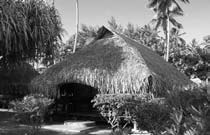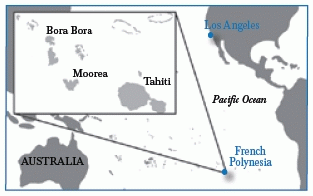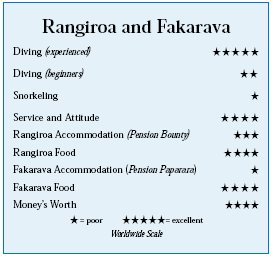Moorea, French PolynesiaContents of this Issue: Dive St. Vincent, St. Vincent & The Grenadines Register for Your Free Online Membership Diver Drifts 12 Hours in Somosomo Strait Serious Diver Impact on the Red Sea Sipadan’s Dive Permit System Keeps Some Divers Out of Its Waters When Bad Air is Pumped into Your Tank Diver Loses Fingers on the Dive Ladder What You’ll Pay on Your Next Dive Trip The Aggressor and Peter Hughes Fleets: Now Under One Owner Editorial Office: Ben Davison Publisher and Editor Undercurrent 3020 Bridgeway, Suite 102 Sausalito, CA 94965 a South Pacific dive gem, or paradise lost? from the January, 2009 issue of Undercurrent
Dear Fellow Diver: “This moray is my friend. I will introduce you.” That’s how Laurent, my Scuba Piti divemaster, briefed my dive at Taotoi. From inquisitive lemon sharks the size of bull sharks to turtles that begged for coral chunks like dogs begging for a bone, the underwater locals had proved to be as friendly as the human ones on land. However, I find it unethical to touch all the marine life. Was it worth the bucks to watch divemasters try to tame it? Now 60 feet under, I debated as a green moray, its head the size of a soccer ball, stretched out of its hole. While wriggling cleaner wrasses swam through the moray’s gills, Laurent stroked its neck. The moray made no offensive move, merely swayed slowly like an underwater cobra. One by one, every diver but I extended a hand toward the eel. Ethics and safety battled with curiosity, but I refrained. I had already dived and snorkeled with sharks in the French Polynesian isles of Bora Bora, Huahine and Fakarava, and I was debating whether to head back to the U.S. or find another local dive paradise. In my book, its great viz, healthy corals, several shark species on every dive, abundance of and variety of fish, including many endemic species, puts French Polynesia far ahead of the Caribbean, Fiji, the Red Sea and the Philippines. It’s pricey, not only for recession-plagued tourists but the locals as well. However, a decrease in passengers is making Air Tahiti Nui offer discounted airfares from Los Angeles, an eight-hour trip, for “long weekend” stays. A round-trip fare to Papeete in December was $765, about 25 percent less than the previous lowest fare. From Papeete’s airport, I went to the ferry dock and I stared at Moorea, a 45-minute ferry ride away for $12.50. Should I invest more francs to dive another island? I fingered my well-worn ATM card and recalled James Michener’s first lines from Tales of the South Pacific (it’s rumored he based his mythical island Bali Hai on Moorea). “I wish I could tell you about the South Pacific. The way it actually was. The endless ocean. The infinite specks of coral we call islands. Coconut palms nodding gracefully toward the ocean. Reefs upon which waves broke into spray, and inner lagoons, lovely beyond description.” That was all I needed. “Passage pour une,” I said to the ferry agent and handed over my francs.
Unlike populous Tahiti, Moorea (Tahitian for “yellow lizard”) is rural and has more of the classic South Pacific get-away-from-it-all ambiance. Multi-hued lagoons are surrounded by jagged, emerald mountains that reach into the clouds. The two-lane paved road circling the 52- square-mile island hugs a white sand coast lined with small communities and the occasional luxury hotel. No trash litters the roadside or beach. Non-French speakers will have no worries. Locals spoke at least some English and were friendly even if using hand signals, and unlike many dive-tourism sites, they don’t press tourists for tips. Silvie, the multilingual Hotel
Hibiscus desk clerk, smiled as she checked
me into one of the 29 farés, thatch-roofed
beachfront bungalows on the edge of a manicured
lawn replete with flamboyant and
vibrant hibiscus. I spent a fitful night on a sagging mattress, then roosters started crowing at 4 a.m. Luckily, my dive buddy and I were ready on time because Daniel, Scuba Piti’s 30- ish, multilingual manager, picked us up promptly. It was a five-minute ride to the dive shop, located on the beach of Hotel Les Tipaniers’s quiet lagoon. A dozen local divers chatted in French while assembling their gear on the shaded outdoor concrete platform next to the shop’s small building. Laurent, the other 30-ish, multilingual instructor, offered me a choice of a long or short steel tank. “If you’re used to diving with aluminum, take two kilos off your weight belt,” he advised. Wearing our gear, we trekked 50 yards across a sturdy boardwalk to the dive boat, a 28-foot motor launch with shade canopy and space for 20 tanks but no head. Ten minutes later, Daniel tied the boat on a mooring line just inside the breakwater. Divers were split into French- and English-speaking groups; the latter consisted of me, my dive buddy and three Australians. Laurent briefed us, “This is Tiki-Pa, Tahitian for ‘nursery.’ We go to a little cave with baby gray sharks. Depth is 70 feet, but not for long. Tell me when you’re low on air; otherwise, we plan a 45-minute dive.” Since none of the English speakers had dived here before, I had expected a check-out dive, but Laurent said nothing, just back-rolled into the 80-degree waters. I descended along the mooring line into a countless swirl of black tip reef sharks. Two eight-foot-long lemon sharks elbowed their way in. I followed Laurent over coral rubble and white sand to a plate coral shelf where he mimed rocking a baby. Under the shelf lay four baby gray sharks. For the remainder of the dive, I reveled in the 150-foot visibility and schools of orange and purple anthias, pennant bannerfish, striped grunts, snapper, lunate-tailed triggerfish and black durgon. Even the usually skittish raccoon butterflyfish and cornetfish allowed photographers within four feet before flitting away. Then a green turtle swam toward Laurent, who broke off a chunk of coral and held it out. Every time the turtle reached for the coral, Laurent teasingly backed away. When the turtle finally got to crunch the coral, photographers lit him with strobe flashes. Apparently, coral-breaking and turtle-teasing was a common practice for this dive crew. I found it ironic because during the dive shop briefing, we were told not to step on coral, tease or touch any marine life. We surfaced 50 minutes later. Two single-foot ladders jutted into the water. Some divers hauled up the ladder completely geared. I took off my fins, tossed them in, then attempted to climb the ladder, only to find the rungs spaced too far apart. A hand shot out, grabbing my first stage and dragging me aboard. “Next time, give me your gear, then climb up,” said Daniel. Telling me after the fact was definitely a black mark.
A 10-minute boat ride brought us to Coma, another site just outside of the lagoon’s breakwater. It was touted as more of a geography dive because the coral ridges are more interesting than animal life. “There may be surge, so watch your gauge,” Laurent warned. He wasn’t kidding. Intent on checking out the little pufferfish, lemon peel angelfish and squirrelfish hiding in the plate coral shelves six feet wide, I followed the sea bottom. Minutes later, I looked up from hawkfish perching on Acropora clusters in my viewfinder to see Laurent and the group swimming 20 feet above me. My gauge read 101 feet. For the rest of the 55-minute dive, I stayed well above Laurent. I noticed that healthy coral was being overwhelmed by rubble and foot-wide crowns-of-thorn starfish. “They’re bad here,” Laurent acknowledged, when I asked topside, adding, “Storms wrecked the reefs, too.” I kept my mouth shut about his breaking off coral to feed the turtle -- and his failure to prevent divers from trodding on the coral to photograph it. On the drive back to Hibiscus, Daniel dropped me off at the Little Tourist Village. I checked out boutiques filled with pareos, bikinis and black pearls before picking up fruit, an unwrapped, yard-long baguette and a whole roasted poulet stuffed with onions and garlic. At $12, the chicken fed two hungry divers, and with the vibrant lagoon view from our porch, it felt like a four-star feast. My faré was roomy and the tiled bathroom had a double sink and hot-water shower, but no TV or towel hooks. I hung my gear on a clothesline on the covered, woodenfloored porch, where I also ate meals at the picnic table. The bungalow was air-conditioned but too cold for my sinuses; however, the ocean breezes and whirring ceiling fan were fine substitutes. Kids splashing in the pool a few feet away and chirping birds didn’t disturb my naps, but damn those roosters. The kitchenette carried only essential eating gear -- no oven or microwave, but a two-burner gas stove and mini-fridge. At the hotel’s beachside, thatch-roofed Sunset Restaurant and Bar, I sat at a picnic table and sampled one of the least expensive offerings: a 14-inch veggie pizza with paper-thin crust, a thinner layer of tomato sauce, a few canned artichoke hearts and mushrooms, and no cheese; it cost $18.75. Salads started at $15; bottled beer and sodas were $10 and $6. I passed up desserts that started at $10 for two scoops of ice cream. After a 15-minute walk from Hibiscus, I discovered Chez Olive, a converted VW bus with built-in kitchen that served heartier, cheaper pizza for $16. As for those outdoor restaurant menus on the way to the grocery, fish and chicken entrees averaged $25 and beef ranged from $30 to $50. Groceries weren’t cheap either, but $25 bought me a few breakfasts’ worth of baguette, fruit, a quarter-pound each of cheese and ham, six eggs and a six-pack of water bottles. I ignored the cheapest wine, at $30 a bottle. Saturday nightlife on the island consisted of two restaurant-bars with live music -- a couple of guitars and vocals playing contemporary rock and American country-western. During the week, streets were deserted, but a twilight beach stroll followed by a candlelit dinner was enough to call it a good day. After two nearly hour-long morning dives on perfect 80-degree days, Daniel would drop me back at the hotel. Scuba Piti devoted afternoons to dive classes, and they didn’t offer night dives. Five of my six dives were inside the breakwater within sight of shore; they started around 70 feet and stair-stepped up to 30 feet. When I asked what the boat carried for emergency gear, I was told oxygen and a cell phone instead of a radio. My dive log reads like ad copy for a tourist brochure. Inquisitive lemon, gray reef, black-tip and white-tip sharks flocked to me on every dive, while remoras latched onto my shark-like, black-clad dive buddy. At La Virgule, tons of triggerfish, surgeonfish and tangs frolicked through a semi-circular coral garden. I found Moorea diving definitely worth the francs, and the tropical-isle views were priceless. While I found the Scuba Piti crew friendly and charming, I don’t like their nonchalant view toward the coral and marine life. However, as a guest in friendly French Polynesia, I felt awkward to chastise them. As a lone, yard-long barracuda joined me on my safety stop, I couldn’t help but feel it was eyeing me reproachingly. Moorea is for divers who want an easily accessible South Pacific paradise; unlike Truk or the Solomons, Moorea only takes a direct, eight-hour LAX-to-Papeete flight, then a short ferry ride over. By watching my converted francs, I paid no more than I would have at an overcrowded Caribbean resort where Americans outnumber the locals, and I got a more gorgeous locale where I didn’t see another dive boat around for my three days of diving. The only con was the cavalier attitude toward the underwater wildlife, so be sure to speak your mind when diving there. --N.M.
|

I want to get all the stories! Tell me how I can become an Undercurrent Online Member and get online access to all the articles of Undercurrent as well as thousands of first hand reports on dive operations world-wide
| Home | Online Members Area | My Account |
Login
|
Join
|
| Travel Index |
Dive Resort & Liveaboard Reviews
|
Featured Reports
|
Recent
Issues
|
Back Issues
|
|
Dive Gear
Index
|
Health/Safety Index
|
Environment & Misc.
Index
|
Seasonal Planner
|
Blogs
|
Free Articles
|
Book Picks
|
News
|
|
Special Offers
|
RSS
|
FAQ
|
About Us
|
Contact Us
|
Links
|
3020 Bridgeway, Ste 102, Sausalito, Ca 94965
All rights reserved.


 The beachfront restaurant
started serving breakfast at 7 a.m. but
because Scuba Piti would be picking divers
up at 7:30, I had to stock my simple
kitchenette with breakfast items besides
the free tea and coffee, plus buy potable
water. I walked 200 yards down the road
to the Little Tourist Village, a shopping
area with ATM and a small grocery, checking
out lunch and dinner menus in French and
English for the half-dozen outdoor restaurants along the way.
The beachfront restaurant
started serving breakfast at 7 a.m. but
because Scuba Piti would be picking divers
up at 7:30, I had to stock my simple
kitchenette with breakfast items besides
the free tea and coffee, plus buy potable
water. I walked 200 yards down the road
to the Little Tourist Village, a shopping
area with ATM and a small grocery, checking
out lunch and dinner menus in French and
English for the half-dozen outdoor restaurants along the way.  Back at the dock, divers hauled
their own gear to the shop to change
tanks. Laurent served hot tea from a
thermos, while one of the local divers
passed around huge chunks of tiramisu
made by his wife. During the 90-minute
surface interval, the local divers, all
of whom spoke excellent English, engaged
us tourists in conversation, as curious
about us as we were about their lives.
I learned more about French politics as
they griped about their current president
Sarkozy.
Back at the dock, divers hauled
their own gear to the shop to change
tanks. Laurent served hot tea from a
thermos, while one of the local divers
passed around huge chunks of tiramisu
made by his wife. During the 90-minute
surface interval, the local divers, all
of whom spoke excellent English, engaged
us tourists in conversation, as curious
about us as we were about their lives.
I learned more about French politics as
they griped about their current president
Sarkozy.  Diver’s Compass: To reach Moorea, take Air Tahiti Nui to Tahiti’s
Faa’a Airport, then either a 10-minute flight to Moorea, or cab five
minutes to Papeete’s ferry dock and take Aremiti’s 45-minute ferry
($25 round trip, no luggage charge); to Moorea hotels, it’s a 45-
minute ride by taxi or private van, or a 90-minute public bus ride
for $3 . . . A six-dive package at Scuba Piti cost $400 and includes
equipment, but they took 10 percent off for those needing only tanks
and weights; no Nitrox . . . Hotel Hibiscus’s prices range from $175
per night for a garden-view fare to $340 for a five-person studio,
not including 20 percent in hotel taxes . . . Internet at Hibiscus is $4.50 for 15
minutes but it’s half that at Photo Magic in the Little Tourist Village . . . Tipping
is not expected, although I did slip the guys a few bills for schlepping my steel
tanks . . . The nearest decompression chamber is on Papeete at Mamao General Hospital
. . . The favorite souvenir is cultured Tahitian pearls, and they’re a deal here; pay
$100 for simple stud earrings that cost $600 in the U.S. . . . Web sites: Scuba Piti
(
Diver’s Compass: To reach Moorea, take Air Tahiti Nui to Tahiti’s
Faa’a Airport, then either a 10-minute flight to Moorea, or cab five
minutes to Papeete’s ferry dock and take Aremiti’s 45-minute ferry
($25 round trip, no luggage charge); to Moorea hotels, it’s a 45-
minute ride by taxi or private van, or a 90-minute public bus ride
for $3 . . . A six-dive package at Scuba Piti cost $400 and includes
equipment, but they took 10 percent off for those needing only tanks
and weights; no Nitrox . . . Hotel Hibiscus’s prices range from $175
per night for a garden-view fare to $340 for a five-person studio,
not including 20 percent in hotel taxes . . . Internet at Hibiscus is $4.50 for 15
minutes but it’s half that at Photo Magic in the Little Tourist Village . . . Tipping
is not expected, although I did slip the guys a few bills for schlepping my steel
tanks . . . The nearest decompression chamber is on Papeete at Mamao General Hospital
. . . The favorite souvenir is cultured Tahitian pearls, and they’re a deal here; pay
$100 for simple stud earrings that cost $600 in the U.S. . . . Web sites: Scuba Piti
(